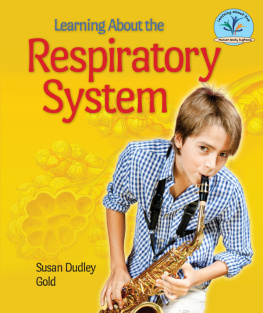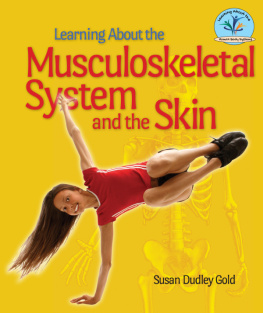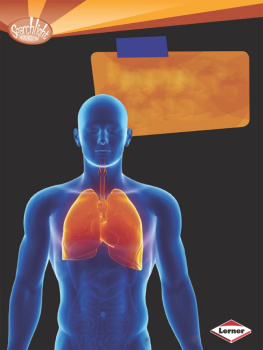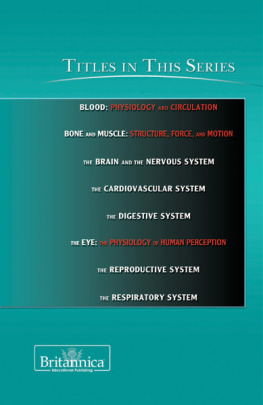Breathe In, Breathe Out
We breathe in oxygen every few seconds and exhale carbon dioxide. The nose, the throat, and the lungs all work together to keep us breathing. The respiratory system also helps protect us from germs and pollutants. Without the respiratory system, we would not be able to smell or talk. Learn more about the important work performed by this extraordinary system.
About the Author
Susan Dudley Gold has written more than two dozen childrens books, many of which focus on health issues. She has also written three books on the history of Maine.

Image Credit: Life Art, Williams & Wilkins
Jennifer Onacki celebrated her twelfth birthday by blowing out twelve candles on her birthday cake. She took a deep breath, closed her eyes and made a wish, then blew as hard as she could. The flames flickered and went out as the stream of air hit.
Throughout this book, Jennifer will serve as an example of how the respiratory system affects our daily lives. Without even thinking, we take a breath every few seconds and almost immediately exhale. This routine keeps us alive. A person whose breathing, or respiration, stops for long enough will die.
The mechanism people use to breathe is called the respiratory system. The nose, the throat, and the lungs are all part of the system. Working together, they bring oxygen gas into the body and expel carbon dioxide gas.
In addition to controlling breathing, the respiratory system helps ward off germs and poisons that might otherwise enter the body through the air. It also warms the air and adds moisture before sending the air into the lungs. Sneezing, coughing, talking, smelling, and the hiccups all involve the respiratory system.
The air a person breathes into the lungs is rich in oxygen. Air also contains a large amount of nitrogen gas. Small amounts of other gases, germs, chemicals, smoke, and pollutants can also be found in the air we breathe.
Oxygen enables the body to use the energy in food (calories). Every cell in the body needs oxygen to do its job. When we breathe, a muscle called the diaphragm contracts, expanding the chest and allowing oxygen-rich air to rush in. Oxygen molecules pass through the walls of the lungs into tiny blood vessels called capillaries. The blood within the capillaries absorbs the oxygen and carries it to tissues throughout the body.
Sometimes a person needs more oxygen than normal. A person who is running or exercising vigorously uses more oxygen than a person who is resting. To get more oxygen to the body, a person breathes faster and takes deeper breaths. The heart beats more rapidly, speeding up the blood carrying oxygen to the bodys cells. If Jennifer Onacki saw her friend across the park and ran to catch up with her, she would use a lot of energy to run. Her body would demand more oxygen. By the time she reached her friend, Jennifer would be breathing very fast indeedpanting, in fact. After resting a bit, however, she would be able to breathe normally again. When people are fearful or excited, they also require more oxygen.

Image Credit: Life Art, Williams & Wilkins
As oxygen enters the bodys tissues, another gascarbon dioxideleaves the cells and flows into the capillaries. Most of the carbon dioxide dissolves in the blood, where it reacts with water to form bicarbonate. This helps keep the blood from becoming too acidic or too alkaline. The bicarbonate and any remaining carbon dioxide molecules travel in the blood to the lungs. When the diaphragm relaxes, the chest compresses, forcing out the carbon dioxide along with the rest of the used air. The cycle repeats as the person inhales, bringing in more oxygen, then exhales, expelling carbon dioxide.
Like other body systems, the respiratory system consists of many parts that work together. From the nose to the lungs, the parts of the respiratory system focus chiefly on getting oxygen into the body and removing carbon dioxide from the body. Each of the major parts of the respiratory team has its own particular job to do. They are divided into two sections: the upper respiratory tract and the lower respiratory tract. The nose and the pharynx, or throat, are part of the upper tract. The lower tract consists of the larynx (the voice box), the trachea (the windpipe), the bronchial system, and the lungs. All along the way, as air passes from the nose to the lungs, the different parts of the system help filter the air and work to keep germs, harmful chemicals, and pollutants away from the sensitive lungs.
The nose handles the respiratory systems first assignment, getting air into the body. Air enters the nostrils and travels through the nasal cavity. As air passes through the nose, coarse hairs in the nostrils stop particles, germs, and other harmful substances from going to the lungs.
Air enters through the mouth and the nose and travels into the pharynx.

Image Credit: Life Art, Williams & Wilkins
A mucous membrane lining the nasal passages secretes mucus, a thick fluid that traps the particles that fall from the nose hair. Embedded in the mucous membrane are tiny hairlike stalks called cilia. The cilia wave continually. This motion forces the mucus to flow out of the nostrils and down to the throat. By swallowing, a person moves the germ-laden mucus out of the throat and into the stomach, where acids dissolve it.
Sometimes smog or other pollutants cause a buildup of mucus in the nose, irritating the mucous membrane. When that happens, a message travels from the membrane to the brain, triggering a sneeze. The sneeze blows the excess mucusand the offending pollutantout the mouth and the nose.
In addition to screening out germs, the nose moistens and warms the air before it enters the lungs. The mucous membrane gives off water vapor, which the air absorbs on its way to the throat. Blood in the capillaries of the nasal passages warms the air.
When a person has a cold, the nose may become blocked by excess mucus. Then the person must breathe through the mouth. Air from the nose and the mouth goes down the trachea to the lungs. But the mouth does not have the same safeguards provided by the nose. When a person breathes through the mouth, some additional germs and cold air may enter the throat and lungs.
The nose also allows us to smell the sweetness of a rose or the mouth-watering aroma of a turkey dinner. Cells at the top of nasal passages called olfactory receptors detect chemicals in the air. A message then travels from the receptors to the brain. The brain processes the information and creates the sensation of smell.
After leaving the nasal passages, air enters the pharynx or throat. The pharynx, a tube about 5 inches (13 cm) long, funnels the air into the larynx. It provides a second layer of defense against germs. As in the nose, a mucous membrane lines the pharynx and traps germs still in the air. Tonsils in the pharynx stand guard against germs that escape the mucus. One set of tonsils, the palatine tonsils, sits on either side of the tongue, at the back of the pharynx. The lingual tonsils are located at the base of the tongue. Adenoids, another type of tonsil, are up high to the rear of the pharynx. White blood cells in the tonsils attack germs and destroy them. Air passing through the pharynx enters the












